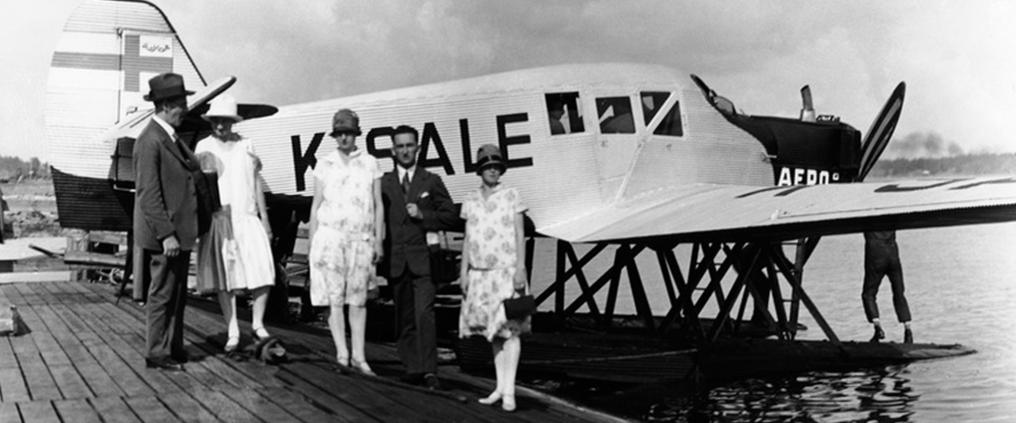Air traffic in Finland is growing strongly, but Finnish aircraft manufacturing has remained relatively unknown. Few know that aircraft began to be manufactured in Finland immediately after independence, shortly after the invention of modern airplanes. Valeri Saltikoff, Exhibition Manager at the Finnish Aviation Museum, explains how aircraft manufacturing in Finland started.
“The state-owned aviation industry originated in Finland in the early 1920s. Major Arne Somersalo, who got appointed Finnish Air Force's commanding officer in 1920, began expanding the aviation yard in Santahamina to become an airplane factory to prepare aircraft for the needs of a newly formed air defence branch”, says Saltikoff.
The Air Force Aviation Plant was founded in the old dry-dock hall in Susisaari, Finland, already in 1921. The main building of Suomenlinna's aviation factory was located in Susisaari's old, reddish dry dock hall. All in all, the factory consisted of ten buildings in Susisaari and Iso Mustasaari.
Suomenlinna's aviation plant originally belonged directly to the Finnish Air Force's organization. In 1928, however, the factory was transferred to the Ministry of Defence as an independent organization called the State Aircraft Factory (Valtion lentokonetehdas).
Along with the factory was also an aviation yard founded in Santahamina in 1918, which focused on aircraft maintenance and repairs. The units of Suomenlinna and Santahamina initially operated as independent organizations until they were merged with the organization reorganization of 1928.
Military aviation dominated
Saltikoff informs that hundreds of planes were built at Suomenlinna, representing several different types of aircraft. The focus was on licensed products based on the drawings acquired abroad. The plant was started up in the years 1922–1926 with the IVL A.22 Hansa seaplanes manufactured on the basis of the German Hansa-Brandenburg W.33 plane license. A total of 120 Hansa planes were built at Suomenlinna.
The aircraft factory also designed several of its own prototypes. However, getting them into serial production proved to be challenging. The first domestic machine that came to the serial production was a VL Sääski jet aircraft, which was produced in 1928-1932, a total of 39 pieces.
The Suomenlinna factory was already originally designed as a temporary solution, and it turned out to be cramped over time. Disaggregated operations for several islands were also logistically difficult, and the location of the mill near the Soviet border was seen as a risk since the 1920s.
In the mid-1930s, the factory moved to new, purpose-built premises in Härmälä, Tampere. Since the beginning of the 1930s, the city of Tampere had actively campaigned for the aviation factory. However, migration to Tampere was not self-evident – Marshal Mannerheim, for example, strongly opposed the placement of the plant in the predominantly red city in the aftermath of the Finnish Civil War.
Sweden and Finland side by side
At the same time aircraft manufacturing was also activated in Finland’s western neighbor: in 1921 Swedish aviation power plant Svenska Aero AB was established.
Founders of the factory were the German aviators Carl Clemens Bücker and Ernst Heinkel. After the First World War, the terms of the Versailles Peace Agreement were virtually denied by the German aircraft industry, so the activity was transferred abroad. Svenska Aero AB initially focused on the licensing of German Heinkel aircraft, but later also developed its own machine types.
In 1932, the poorly successful Svenska Aero was sold to ASJA, the Swedish railway manufacturer ASJ's aircraft subsidiary. In the latter half of the 1930s, ASJA joined the other Swedish industrial companies, forming between 1937 and 1939 the Svenska Airoplan Aktiebolaget company, SAAB, which many know best from its Saab passenger cars.
Saltikoff explains that the pre-WW2 aviation industry was heavily dominated by military aviation both in Finland and Sweden. Both the Finnish State Aviation Factory and the Swedish companies mentioned had the main task of producing aircraft for the use of the defence forces. In the early days, however, the limit between civilian and military airplanes was not very steep. Many types of aircraft of the 1920s - for example the Finnish VL Sääski - could be used both for military and civil purposes. Aircraft development and manufacturing, however, remained in military aircraft until the end of the Second World War, after which civil aviation became predominant.
The second part of the story tells what happened to the Finnish aircraft production after the Second World War, and why Sweden is well known for its fighter planes today.
Read about Finnish Aviation in the 1920s and other instalments in the history series



